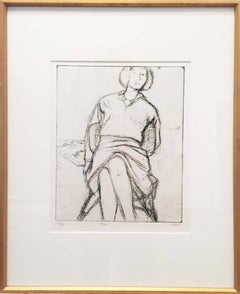Phyllis Diebenkorn
Late 20th Century Abstract Expressionist Figurative Prints
Etching
1960s Figurative Prints
Etching
Recent Sales
Late 20th Century Abstract Expressionist Figurative Prints
Drypoint
Late 20th Century Abstract Expressionist Figurative Prints
Etching
1960s Portrait Prints
Drypoint, Etching
Vintage 1960s American Drawings
Paper
People Also Browsed
1960s Abstract Expressionist Figurative Prints
Lithograph
1960s Abstract Expressionist Figurative Prints
Lithograph
Richard Diebenkorn for sale on 1stDibs
Known for his gestural yet geometric depictions of American landscapes, Richard Diebenkorn blended Abstract Expressionism and figurative painting like no other artist before him.
Born in Portland, Oregon, but raised in San Francisco, California, Diebenkorn studied art history at Stanford University before enlisting in the Marines. Afterward, on the G.I. Bill, he enrolled at California School of Fine Arts (now San Francisco Art Institute) in 1946, where he became an instructor a year later. In 1950, he pursued a master’s degree at the University of New Mexico.
He lived and worked for a period during the postwar years in New York City, where he met Mark Rothko and immersed himself in Robert Motherwell’s art. However, the perspective that Diebenkorn brought to his paintings and prints was firmly rooted in the West Coast. His canvases, even when he worked in an abstract style, evoked California’s sandy coastlines and varied topography — one of the attributes that set him apart from contemporaries such as Willem de Kooning and Philip Guston.
Diebenkorn is acclaimed for his representational paintings; he was a founding member of the Bay Area Figurative movement, along with David Park and Elmer Bischoff. But he is best known for his lyrical abstract work. He explored abstraction during the 1950s before switching to figuration — creating still lifes and working with live models — and then returned to abstraction, developing a distinctive style that was entirely his own.
When Diebenkorn moved to Southern California, he began to teach at UCLA and commenced work on what would become his enduring “Ocean Park” series, named for the Santa Monica suburb he called home as of 1966 and inspired by the view from his studio — in particular, the light on the landscape outside the windows as framed by the windows themselves. The influence of Henri Matisse loomed large too. Diebenkorn had been an admirer of Matisse’s work since his days in the military, and in 1964, a trip to see the French painter’s work at the State Hermitage Museum in Leningrad proved monumental for him.
The “Ocean Park” series, created over the span of two decades, comprised more than 140 large paintings with gentle, shimmering compositions of color arranged in geometric harmony, with the texture of Diebenkorn’s constant reworking of the paint coming through.
“All paintings start out of a mood, out of a relationship with things or people, out of a complete visual impression,” Diebenkorn once said. Today, his work can be found in the collections of the Whitney Museum of American Art, the Phillips Collection, the Los Angeles County Museum of Art and more.
Find authentic Richard Diebenkorn art on 1stDibs.
Finding the Right Prints-works-on-paper for You
Decorating with fine art prints — whether they’re figurative prints, abstract prints or another variety — has always been a practical way of bringing a space to life as well as bringing works by an artist you love into your home.
Pursued in the 1960s and ’70s, largely by Pop artists drawn to its associations with mass production, advertising, packaging and seriality, as well as those challenging the primacy of the Abstract Expressionist brushstroke, printmaking was embraced in the 1980s by painters and conceptual artists ranging from David Salle and Elizabeth Murray to Adrian Piper and Sherrie Levine.
Printmaking is the transfer of an image from one surface to another. An artist takes a material like stone, metal, wood or wax, carves, incises, draws or otherwise marks it with an image, inks or paints it and then transfers the image to a piece of paper or other material.
Fine art prints are frequently confused with their more commercial counterparts. After all, our closest connection to the printed image is through mass-produced newspapers, magazines and books, and many people don’t realize that even though prints are editions, they start with an original image created by an artist with the intent of reproducing it in a small batch. Fine art prints are created in strictly limited editions — 20 or 30 or maybe 50 — and are always based on an image created specifically to be made into an edition.
Many people think of revered Dutch artist Rembrandt as a painter but may not know that he was a printmaker as well. His prints have been preserved in time along with the work of other celebrated printmakers such as Pablo Picasso, Salvador Dalí and Andy Warhol. These fine art prints are still highly sought after by collectors.
“It’s another tool in the artist’s toolbox, just like painting or sculpture or anything else that an artist uses in the service of mark making or expressing him- or herself,” says International Fine Print Dealers Association (IFPDA) vice president Betsy Senior, of New York’s Betsy Senior Fine Art, Inc.
Because artist’s editions tend to be more affordable and available than his or her unique works, they’re more accessible and can be a great opportunity to bring a variety of colors, textures and shapes into a space.
For tight corners, select small fine art prints as opposed to the oversized bold piece you’ll hang as a focal point in the dining area. But be careful not to choose something that is too big for your space. And feel free to lean into it if need be — not every work needs picture-hanging hooks. Leaning a larger fine art print against the wall behind a bookcase can add a stylish installation-type dynamic to your living room. (Read more about how to arrange wall art here.)
Find fine art prints for sale on 1stDibs today.
